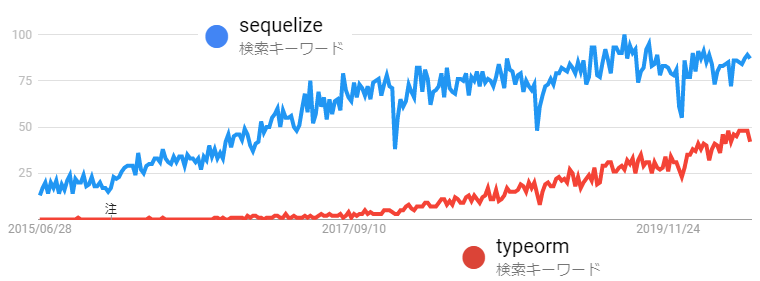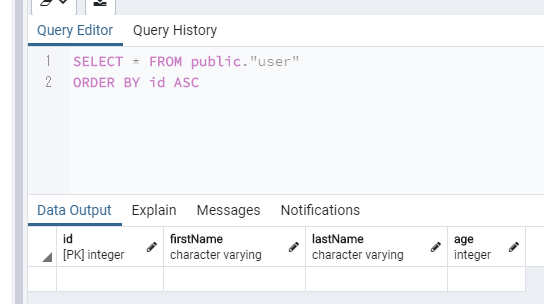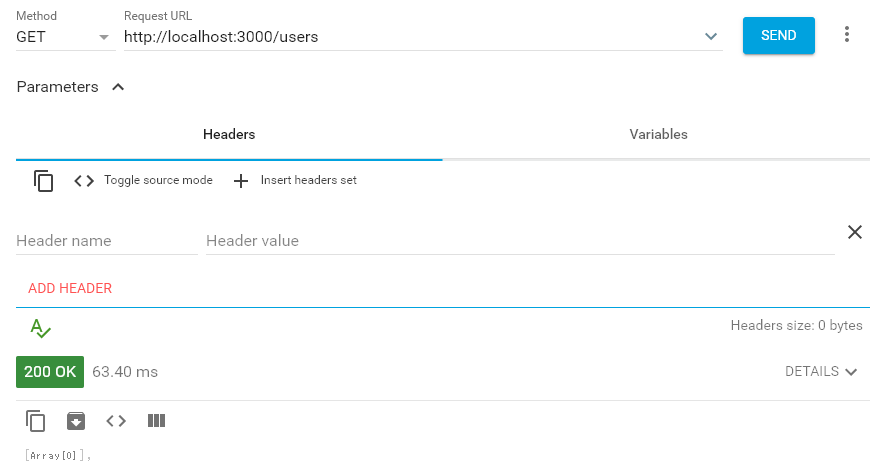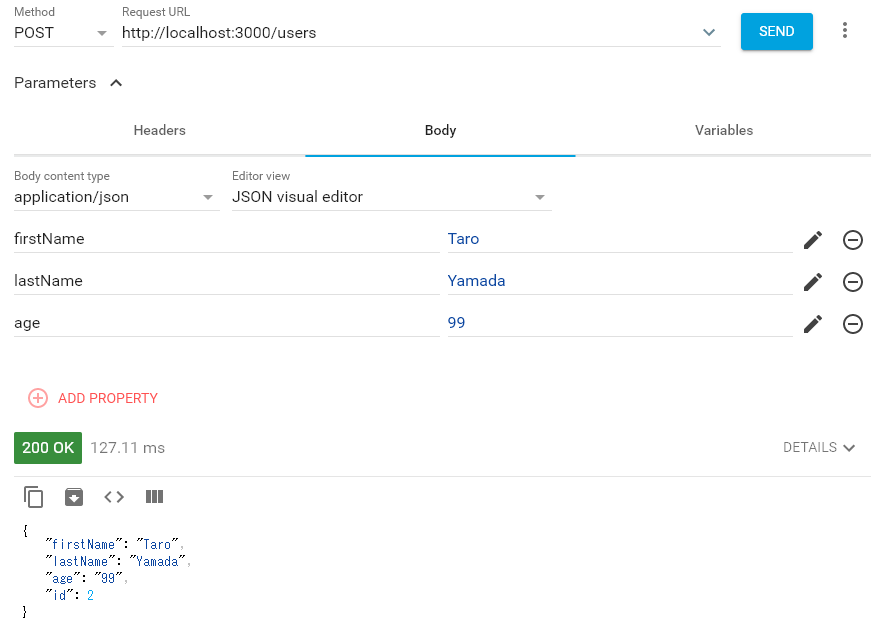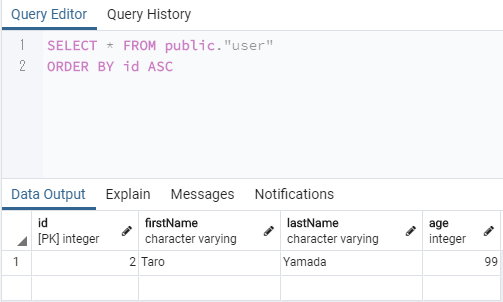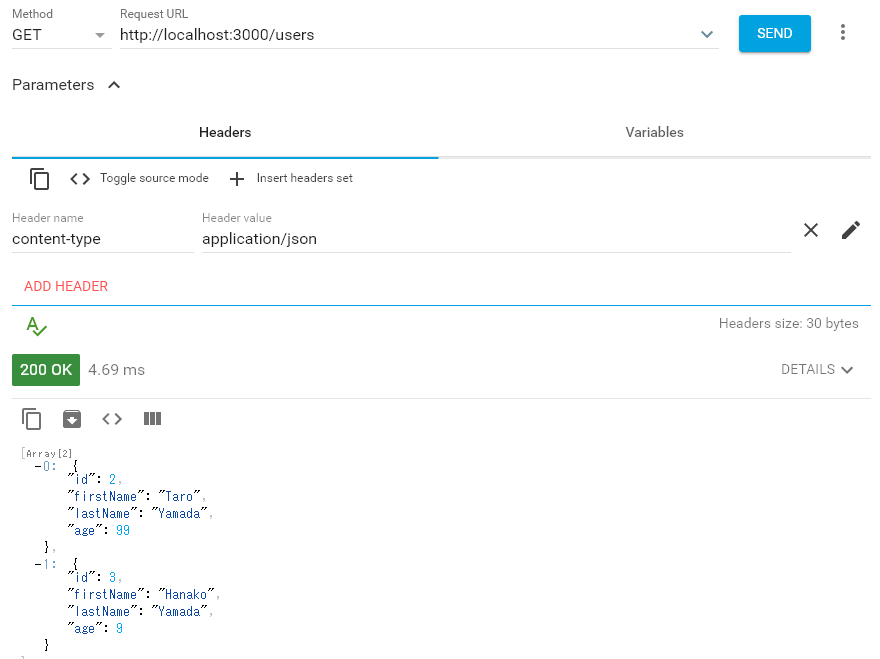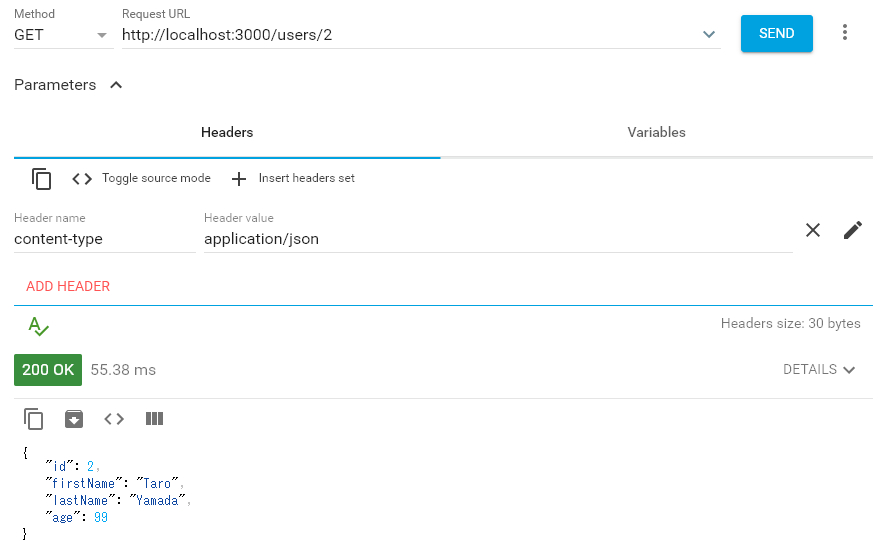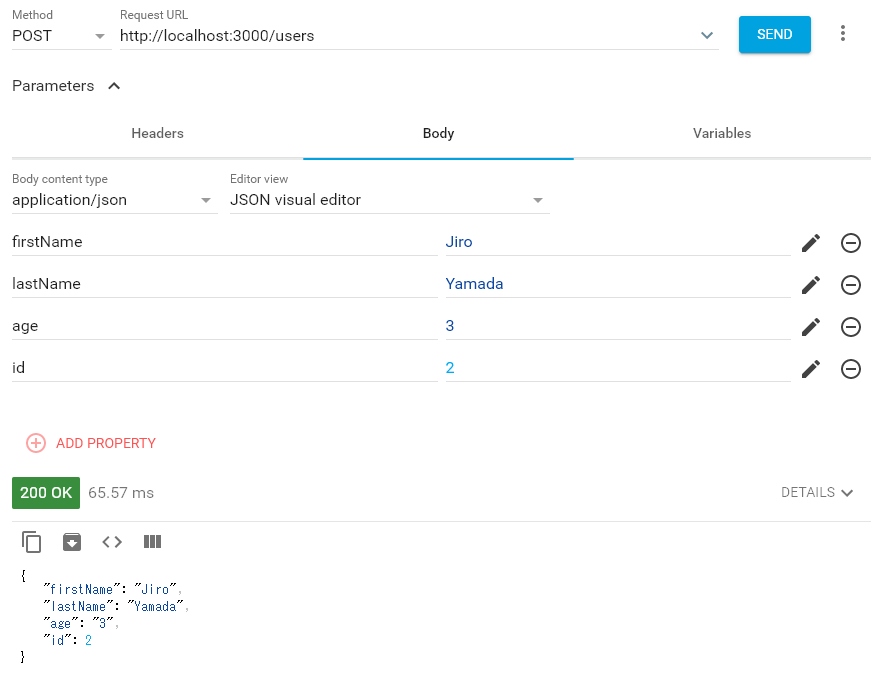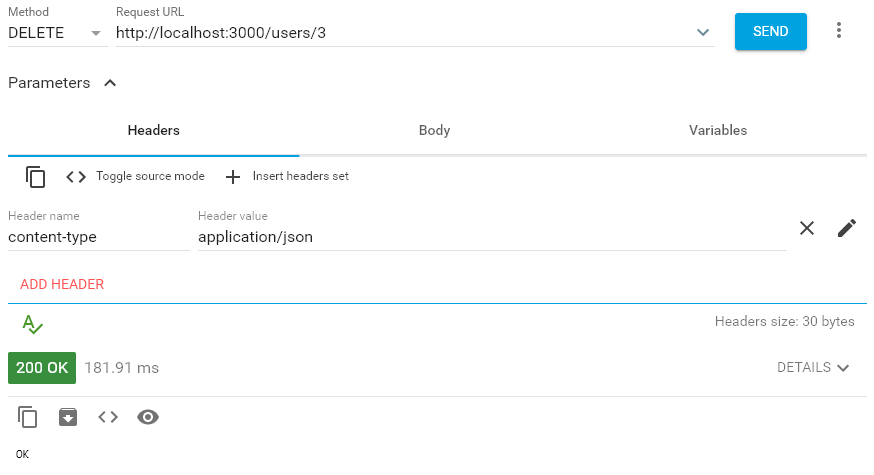背景
前回、sequelizeを利用したコードのtypescript化を試みて、modelの呼び出し元はtypescriptっぽく書くようにできたけど、モデル自体はtypescript化できずに、中途半端な感じで終わってしまった。
sequelizeは、元々typescriptをサポートしていなかったため、typescriptと少し相性が悪いとの記事もいくつか見つけた。
そこで今回は最近伸びてきているTypeORMを試してみようと思う。
こちらは元々typescriptが前提となっているORMなので、typescript化で苦労することはなさそう。
googleトレンドで見ると、sequelizeに追いつく勢いで伸びてきている。
(むしろtypescriptに限定すれば、既にTypeORMの方が人気がある気がする)
TypeORMのCLIを使った環境構築
DBは以前インストールしたpostgresql(windows)を利用する。
https://qiita.com/yusuke-ka/items/448843020c0406363ba5#%E6%BA%96%E5%82%99
pgadmin4でデータベースインスタンスだけ作っておく。
データベース名("typeorm"とした)を入力して作成。
ここからは、コード エディタ(VS Code)上での作業。
まずはベースとなるnode環境を作る。
> mkdir typeorm
> cd typeorm
> yarn init
検証なので、とりあえず全部デフォルト設定。
続いて、TypeORMのインストール。
また、DBはpostgresqlを使うのでpg(node-postgres)もインストール。
> yarn add typeorm
> yarn add pg
TypeORMのCLIがyarnで簡単に使えるようにpackage.jsonに以下を追加しておく。
{
...
"scripts": {
"typeorm-cli": "typeorm"
},
...
}
TypeORMのCLIを使って、express、postgresqlのTypeORM環境を一気に構築。
> yarn typeorm-cli init --express --database postgres
自動で以下のようなフォルダ/ファイルが生成される。
|- typeorm/
|- src/
|- controller/
|- UserController.ts
|- entry/
|- User.ts
|- migration/
|- index.ts
|- routes.ts
|- ormconfig.json
|- tsconfig.json
設定ファイル(ormconfig.json)で接続先DBに合わせて設定を変更。
{
"type": "postgres",
"host": "localhost",
"port": 5432,
"username": "postgres",
"password": "postgres",
"database": "typeorm",
"synchronize": true,
"logging": false,
"entities": ["src/entity/**/*.ts"],
"migrations": ["src/migration/**/*.ts"],
"subscribers": ["src/subscriber/**/*.ts"],
"cli": {
"entitiesDir": "src/entity",
"migrationsDir": "src/migration",
"subscribersDir": "src/subscriber"
}
}
今回は以下だけ変更。
...
"username": "postgres",
"password": "postgres",
"database": "typeorm",
...
これでTypeORMの環境構築は完了。簡単ですね。
TypeORMのCLIで自動構築された環境の確認
CLIで作成すると、サンプルとして"User"というモデルを操作するコードが自動で入っている。
自動生成されたモデル(src/entry/User.ts)は以下のようになっている。
import {Entity, PrimaryGeneratedColumn, Column} from "typeorm";
@Entity()
export class User {
@PrimaryGeneratedColumn()
id: number;
@Column()
firstName: string;
@Column()
lastName: string;
@Column()
age: number;
}
モデルを定義するときは、これを真似して<モデル名>.tsをentryフォルダ以下に配置すればよい模様。
続いて、コントローラー(src/controller/UserController.ts)は以下のようになっていた。
import {getRepository} from "typeorm";
import {NextFunction, Request, Response} from "express";
import {User} from "../entity/User";
export class UserController {
private userRepository = getRepository(User);
async all(request: Request, response: Response, next: NextFunction) {
return this.userRepository.find();
}
async one(request: Request, response: Response, next: NextFunction) {
return this.userRepository.findOne(request.params.id);
}
async save(request: Request, response: Response, next: NextFunction) {
return this.userRepository.save(request.body);
}
async remove(request: Request, response: Response, next: NextFunction) {
let userToRemove = await this.userRepository.findOne(request.params.id);
await this.userRepository.remove(userToRemove);
}
}
ここではモデルに対する操作を書く感じですね。
全件取得、1件取得、保存(作成/更新)、削除の機能がサンプルとして実装されている。
getRepository(Hoge)で取得されるRepositoryをTypeORMが提供してくれているので、このRepositoryのメソッド(findやsaveなど)を呼び出して、DBにアクセスしているっぽい。
次は、index.ts。expressを使用する感じで自動生成されている。
import "reflect-metadata";
import {createConnection} from "typeorm";
import * as express from "express";
import * as bodyParser from "body-parser";
import {Request, Response} from "express";
import {Routes} from "./routes";
import {User} from "./entity/User";
createConnection().then(async connection => {
// create express app
const app = express();
app.use(bodyParser.json());
// register express routes from defined application routes
Routes.forEach(route => {
(app as any)[route.method](route.route, (req: Request, res: Response, next: Function) => {
const result = (new (route.controller as any))[route.action](req, res, next);
if (result instanceof Promise) {
result.then(result => result !== null && result !== undefined ? res.send(result) : undefined);
} else if (result !== null && result !== undefined) {
res.json(result);
}
});
});
// setup express app here
// ...
// start express server
app.listen(3000);
// insert new users for test
await connection.manager.save(connection.manager.create(User, {
firstName: "Timber",
lastName: "Saw",
age: 27
}));
await connection.manager.save(connection.manager.create(User, {
firstName: "Phantom",
lastName: "Assassin",
age: 24
}));
console.log("Express server has started on port 3000. Open http://localhost:3000/users to see results");
}).catch(error => console.log(error));
routes.tsに定義されているRouteをforEachで回しているようなので、新しいAPIを追加するときには、このコード(index.ts)は変更せずに、routes.tsに定義を追加すれば良さそう。
最後のほうにある
// insert new users for test
以下はサーバー起動時にテストデータを入れているコードのようなので、実際に利用する際には消しておいた方がよさそう。
というか必要ないので、さっそく消しておく。
import "reflect-metadata";
import {createConnection} from "typeorm";
import * as express from "express";
import * as bodyParser from "body-parser";
import {Request, Response} from "express";
import {Routes} from "./routes";
createConnection().then(async connection => {
// create express app
const app = express();
app.use(bodyParser.json());
// register express routes from defined application routes
Routes.forEach(route => {
(app as any)[route.method](route.route, (req: Request, res: Response, next: Function) => {
const result = (new (route.controller as any))[route.action](req, res, next);
if (result instanceof Promise) {
result.then(result => result !== null && result !== undefined ? res.send(result) : undefined);
} else if (result !== null && result !== undefined) {
res.json(result);
}
});
});
// setup express app here
// ...
// start express server
app.listen(3000);
console.log("Express server has started on port 3000. ");
}).catch(error => console.log(error));
routes.tsを見てみる。これも自動生成されている。
import {UserController} from "./controller/UserController";
export const Routes = [{
method: "get",
route: "/users",
controller: UserController,
action: "all"
}, {
method: "get",
route: "/users/:id",
controller: UserController,
action: "one"
}, {
method: "post",
route: "/users",
controller: UserController,
action: "save"
}, {
method: "delete",
route: "/users/:id",
controller: UserController,
action: "remove"
}];
サンプルとして、全件取得、1件取得、追加(更新)、削除の4つのAPIが定義されている模様。
最後に設定系のファイルを見てみる。
typeORMの設定ファイル(ormconfig.json)は、先ほど見たので、package.jsonから。
{
"name": "typeorm",
"version": "1.0.0",
"main": "index.js",
"license": "MIT",
"scripts": {
"typeorm-cli": "typeorm",
"start": "ts-node src/index.ts"
},
"dependencies": {
"typeorm": "0.2.25",
"reflect-metadata": "^0.1.10",
"pg": "^7.3.0",
"express": "^4.15.4",
"body-parser": "^1.18.1"
},
"devDependencies": {
"ts-node": "3.3.0",
"@types/node": "^8.0.29",
"typescript": "3.3.3333"
}
}
scriptsにstartが追加されている。これでサーバーを実行する模様。
あとは、必要な依存が自動的に追加されている。
tsconfig.jsonも確認。
{
"compilerOptions": {
"lib": [
"es5",
"es6"
],
"target": "es5",
"module": "commonjs",
"moduleResolution": "node",
"outDir": "./build",
"emitDecoratorMetadata": true,
"experimentalDecorators": true,
"sourceMap": true
}
}
typeORMのREADMEに書いてある設定が自動的に入っているようです。
https://github.com/typeorm/typeorm#installation
TypeORMのサンプルコードを実行してみる。
TypeORMのコードを実行してみようと思う。
まずは、モデルをDBに反映してみる。
migration:generateを実行すると、DBの内容とモデルを比較してマイグレーションファイルを作成してくれるようなので、これを実行してみる。
> yarn typeorm-cli migration:generate -n UserMigration
エラーが発生した。
yarn run v1.22.4
$ typeorm migration:generate -n UserMigration
Error during migration generation:
D:\study\orm\typeorm\src\entity\User.ts:1
import {Entity, PrimaryGeneratedColumn, Column} from "typeorm";
^^^^^^
SyntaxError: Cannot use import statement outside a module
...
本家サイトのここを参考にしてやってみる。
https://github.com/typeorm/typeorm/blob/master/docs/using-cli.md#installing-cli
package.jsonのscriptsを以下のように変更(typeormのscriptを追加)。
(ts-nodeは自動でインストールされているはずだけど、もし入っていなければ、インストールする必要があるかも)
...
"scripts": {
"typeorm-cli": "typeorm",
"typeorm": "node --require ts-node/register ./node_modules/typeorm/cli.js",
"start": "ts-node src/index.ts"
},
...
再度実行してみる。
(今度は、yarn typeorm-cliではなく、yarn typeorm)
> yarn typeorm migration:generate -n UserMigration
今度は成功。
yarn run v1.22.4
$ node --require ts-node/register ./node_modules/typeorm/cli.js migration:generate -n UserMigration
Migration D:\study\orm\typeorm/src/migration/1593226939171-UserMigration.ts has been generated successfully.
Done in 2.03s.
こんな感じでマイグレーションファイルが生成された。
import {MigrationInterface, QueryRunner} from "typeorm";
export class UserMigration1593226939171 implements MigrationInterface {
name = 'UserMigration1593226939171'
public async up(queryRunner: QueryRunner): Promise<void> {
await queryRunner.query(`CREATE TABLE "user" ("id" SERIAL NOT NULL, "firstName" character varying NOT NULL, "lastName" character varying NOT NULL, "age" integer NOT NULL, CONSTRAINT "PK_cace4a159ff9f2512dd42373760" PRIMARY KEY ("id"))`);
}
public async down(queryRunner: QueryRunner): Promise<void> {
await queryRunner.query(`DROP TABLE "user"`);
}
}
DBに反映させてみる。
> yarn typeorm migration:run
userテーブルが作成された。
サーバーを起動。
> yarn start
今回もchromeの拡張ツール「Advanced REST client」で動作確認。
http://localhost:3000/users に各種リクエストを送ってみる。
routes.tsに定義されているRouteを見てURLを指定。
まずは全件取得。
何も登録してないので、結果は空の配列。
つづいて、ユーザーを登録してみる。
application/jsonで指定したパラメータでユーザーが登録された。
DBにも登録されている。
同様にもう一人ユーザーを追加した後、再度全件取得してみる。
今度は配列が空じゃない状態で返ってきた。
パスにIDを指定して取得。
1件だけ返ってきた。
データ更新。
パラメータにID(integer)を指定してPOSTリクエストを送る。
データが更新された。
最後に、削除を試してみる。
DBからデータが消えているようだが、レスポンスが返ってこない。
index.tsでresultがundefinedの時にレスポンスを返していないのが原因かと思われる。
...
// register express routes from defined application routes
Routes.forEach(route => {
(app as any)[route.method](route.route, (req: Request, res: Response, next: Function) => {
const result = (new (route.controller as any))[route.action](req, res, next);
if (result instanceof Promise) {
result.then(result => result !== null && result !== undefined ? res.send(result) : undefined); // ← ココ
} else if (result !== null && result !== undefined) {
res.json(result);
}
});
});
...
試しに200を返すように書き換えてみる。
...
// register express routes from defined application routes
Routes.forEach(route => {
(app as any)[route.method](route.route, (req: Request, res: Response, next: Function) => {
const result = (new (route.controller as any))[route.action](req, res, next);
if (result instanceof Promise) {
result.then(result => result !== null && result !== undefined ? res.send(result) : res.send(200)); // ← ココ
} else if (result !== null && result !== undefined) {
res.json(result);
}
});
});
...
他のIDを指定して削除を再実行。
今度はレスポンスが返ってきた。
修正が正しいかどうかは置いといて、原因は特定できた。
さいごに
今回はTypeORMの環境構築を試してみた。
いくつかハマりポイントはあったもののsequelizeをtypescript化するよりは遥かに楽だったし、モデルもコントローラーもすべてtypescriptで書けそうなので、sequelizeの時のように中途半端な感じにならないのも良さげ。
(もう少し時間をかけて調べれば、sequelizeもいい感じにtypescript化できる方法があるのかもしれないけど…)
sequelizeほど成熟していない感はあるものの、typescriptで書くことが前提ならTypeORMの方がやりやすい気がします。
